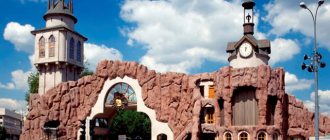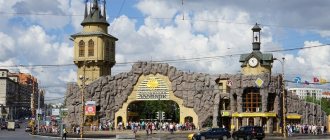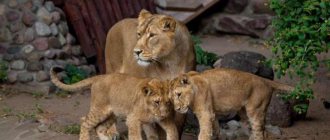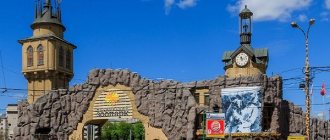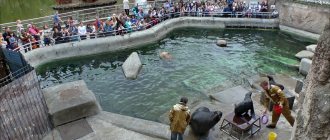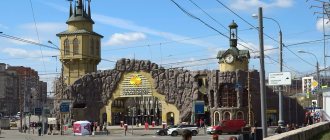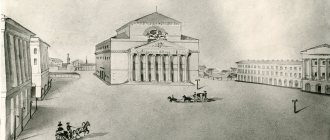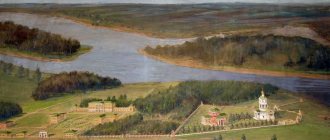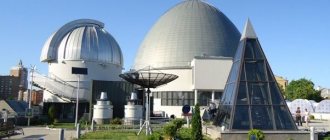One of the oldest European zoos is located in the center of Moscow. More than 8,000 animals thrive in pavilions, spacious enclosures and ponds. Zoo staff are not only involved in the care and treatment of pets. A lot of attention is paid to scientific activities and cooperation with international environmental organizations.
The territory of the zoo is perfectly equipped, there is everything to make visitors of all ages feel comfortable - shady areas, cafes, drinking fountains, children's attractions. The zoo's pets in equipped enclosures look healthy and well-groomed, and judging by their behavior, they feel great in the center of a multimillion-dollar city. Photos and a brief description of the zoo's collection are posted in all tourist advertising materials in Moscow.
Story
The place where the zoo is located today has long been called Presnensky Ponds. In the river valley Presnya had many gardens and hay meadows, and Muscovites loved to stroll here. The zoo was created by employees of Moscow University with funds provided by wealthy residents of the city and members of the royal family.
At the time of discovery, one and a half hundred wild animals, about the same number of domestic animals and several species of reptiles lived in enclosures and cages. Most of them represented the fauna of the Russian Empire. In the new Moscow zoo one could see wolves, bears, moose, hares, foxes, squirrels and hedgehogs. Among the exotic animals kept in Moscow were a rhinoceros, a leopard, a crocodile, a jaguar and two lions.
View of the large pond
The new zoo was not only a public entertainment place, but also played the role of a large scientific center. Its employees successfully bred new domestic breeds and acclimatized purebred animals brought from different parts of the world.
Almost every year the zoo sent expeditions to exotic countries, and they were engaged in capturing wild animals. In addition, the collection of animals was regularly replenished with gifts from the imperial family.
Together with the whole country, the zoo survived the revolutions and wars of the 20th century. But in difficult times, experienced biologists and enthusiasts were always next to the animals, whose dedication and work helped preserve and increase the unique collections of animals and birds.
Flamingo
Through hardship to the stars
Unfortunately, in subsequent years the situation of the zoo was not always wonderful and cloudless. It has faced many difficulties throughout its history. Material losses and debts oppressed the zoo managers, tied their hands, and did not allow the complex to develop.
This local area suffered greatly during the revolution in 1905 - 1907; extensive fires and fighting brought it into a state of decline. Many buildings, an archive and a library burned down, a large aquarium was destroyed, and many animals died. The zoo, not having time to recover from the horrors and problems that befell it, suffered from a flood. The first years of the October Revolution were a particularly painful blow for this corner of paradise. The zoo was threatened with complete destruction, but there were caring “saviors” who helped to survive and overcome all the bad weather. The years of the Great Patriotic War were also very difficult times for this place. Despite these hardships and troubles, the Moscow Zoo still delights visitors with its wonderful atmosphere and huge collection of animals.
Old territory
In terms of area, the Moscow Zoo is second only to the zoo in Yaroslavl. Today, in the capital you can see more than 1,150 species of fauna from all over the world. Almost 9,000 animals and birds are exhibited in cages, enclosures, pools, ponds and terrariums.
The territory is divided into two parts - Old and New, and you can cross from one to the other via a pedestrian bridge. The old part of the zoo displays a large collection of Russian animals and birds. Foxes, white and brown hares, a pair of wolves, raccoon dogs, sables and martens live here. The spacious enclosures are home to typical birds of our forests - jackdaws, magpies, pileated woodpeckers, crows and jays.
Aviary with elephants
While walking through the Old Territory, your child can be shown animals and birds brought from Australia and South America. This part of the zoo houses giraffes, tapirs, spectacled bears, musk oxen, wildebeest, sea lions and large cats from the tropics.
One of the most popular places is the spacious elephant barn. It is curious that the zoo received its first elephant as a gift from Russian Emperor Alexander II. Today, the zoo's elephant enclosure houses several Indian elephants.
Next to the pedestrian bridge, near Bolshaya Gruzinskaya Street, there are cages with raccoons, sloths, armadillos and Japanese macaques. In addition, in the old part of the zoo you can see many birds. The Bird House with exotic birds, the Birds of Prey Rock and the Crane Nursery are located here.
Aviary with lions
Moscow Zoo
Video: Moscow Zoo
Basic moments
The Moscow Zoo has long gained worldwide fame thanks to its innovative activities; its zoologists have bred several unique breeds of animals. The zoo takes part in prestigious international environmental programs for the conservation of endangered species of fauna, and is a member of the World and European Association of Zoos and Aquariums (WAZA and EAZA), the Euro-Asian Regional Association of Zoos and Aquariums (EAPAZA).
The zoological park, which became popular among Muscovites back in the 19th century, is conventionally divided into Old and New territories, connected by the Transition Bridge hanging over Bolshaya Gruzinskaya Street. Both areas are perfectly equipped for a comfortable stay for visitors. There are many green areas with flower beds, cafes, comfortable benches in the shade, and fountains with filtered drinking water. Several dozen exhibits with animals are scattered throughout the zoo and represent individual geographic regions of their habitat, zoological families, and species. You can spend more than one hour at each of the exhibitions, watching our well-fed and well-groomed smaller brothers, who feel surprisingly at ease in the very center of a huge metropolis.
History of the Moscow Zoo
The Moscow Zoo dates back to February 12, 1864 (January 31, old style). On this day, a zoo was pompously opened at Presnensky Ponds, which soon became one of the most attractive and visited corners of Moscow. Actually, Presnensky ponds have long been popular among Muscovites: at the end of the 18th century, the royal menagerie was located here, and at the beginning of the 19th century, the actual Privy Councilor Pyotr Valuev, who acquired the ownership of the ponds and the land around them, introduced the “Presnensky festivities” into the city tradition. Then the land near the Presnensky Ponds with its green hills, water meadows and flowering gardens was allocated to the Imperial Russian Society for the Acclimatization of Animals and Plants for the construction of a zoo. At the origins of its creation were Russian biologists - Moscow University professors Karl Roulier, Anatoly Bogdanov and Sergei Usov.
Not only professional biologists, but also amateur naturalists from different strata of Moscow society were enthusiastic about the creation of the zoo. By the time of its opening, the zoo already had a “living collection” of three hundred wild and domestic animals, mainly representing the fauna of the Russian Empire. Maintaining a zoo was a troublesome and expensive task, and it owed its fairly prosperous existence mainly to patrons of the arts. For example, Emperor Alexander II presented the zoo with an Indian elephant, Grand Duke Constantine - a rhinoceros, Vice-Sultan of Egypt Ismail Pasha - a zebra, Rear Admiral Ivan Butakov, commander of the frigate "Svetlana", who returned from a trip around the world - exotic animals of the Australian continent , the rector of the Valaam Monastery, Father Damascene - Ladoga seals and reindeer. A large group of animals came from the Paris Acclimatization Garden.
The purpose of creating the zoo was not only to demonstrate the diversity of the planet's fauna. An experimental base for scientific and practical work was also established here. Based on the crossing of domestic and imported animals, new, elite breeds were developed; they could be purchased at exhibitions periodically held at the zoo.
After the revolution, the zoo was nationalized in 1919, and in 1923 it came under the jurisdiction of the Moscow City Council. From 1924 to 1928, the head of the zoo was the famous Russian biologist Mikhail Zavadovsky. During this period, the zoo grew with additional land, where such corners as “Polar World”, “Turya Gorka”, “Island of Animals” were equipped - an area where animals were kept not in cages, but in spacious enclosures, separated from visitors by a moat with water . The zoo itself began to be called a zoo.
The Moscow Zoo did not stop working during the Great Patriotic War. Its dedicated employees did not leave their pets unattended even during air raids, calming the frightened animals with their presence and care. In the 50-70s, the management was Igor Sosnovsky, known for his articles and books about animals and about the zoo itself, thanks to which the popularity of the menagerie grew year by year.
By the 90s, the zoo had become noticeably dilapidated, and a decision was made to carry out a general reconstruction here. During the work, more than five dozen spacious housing for animals were built, and most of the utilities were updated. At the same time, new exhibitions opened, featuring animals that had not previously been shown in the zoo. At the same time, a zoo nursery for the reproduction of rare, valuable and endangered species of animals was established in the Moscow region. Today it boasts such “rarities” as Far Eastern leopards, Transbaikal Pallas' cats, cheetahs, Amur tigers, Central Chinese red wolves, blue sheep, the collection continues to grow.
Old territory
The first thing that guests of the Moscow Zoo see after passing the main entrance is the Big Pond. The reservoir is famous not only for the huge number of waterfowl, but also for its history, which dates back to the year the zoo was founded. Over more than 150 years, the outlines of its coasts and islands have, of course, changed, but birds still live here all year round. The water in the pond is regularly cleaned and aerated; in winter, powerful compressors maintain ice-free water.
On artificial islands built on concrete foundations, you can see houses - these are nesting places for birds. They were specially placed further from the shore so that the birds would not be disturbed.
Among the inhabitants of the Big Pond are the gray goose and the bean goose, which is very similar to it, inhabitants of Europe and Asia, the Far Eastern swan goose (a very rare bird), the white goose, common in North America, Yakutia and Wrangel Island, the Magellanic goose, listed in the Red Book of Russia. The Big Pond is also home to mute swans, tundra swans, the smallest in the world, black-necked swans from South America and Australian black swans. In the shallow waters of the Big Pond, flamingos live in a specially created enclosure. There are an incredible number of bright orange ducks here. There is no need to keep them in the zoo, and in the spring some of them scatter throughout Moscow.
To the west of the Big Pond, many beloved representatives of the cat family rule. In the enclosures closest to the pond there are “fast” cheetahs. They have not lost their predatory skills, but, deprived of the opportunity to hunt antelope, they are content with hunting sparrows, crows and pigeons, which inadvertently fly into their territory.
A little further away is the “Cats of the Tropics” pavilion. Its owners are a jaguar and a handsome blue-eyed white tiger, one of the largest representatives of the cat family. In the summer, the predators walk in open, picturesque enclosures, and in the winter they take refuge within the walls of the pavilion, although the white tiger periodically comes out for a walk on frosty days. In the neighboring “Cat Row” there are enclosures where medium-sized cats live: lynxes, Far Eastern leopards, snow leopards, pumas.
Not far from the “cat kingdom” there is a yellow two-story house built back in 1892. Until 1914, meetings of the Imperial Russian Society for the Acclimatization of Animals and Plants were held here, and during the First World War, a hospital was located on the second floor of the building. After the revolution, the administration of the Moscow Zoo was located here. Today, the Zoo History Museum is located on the second floor.
This building was called the “House of the Giraffe”, since on the ground floor lives the brightest and most famous of all the inhabitants of the Moscow Zoo, the public’s favorite - the giraffe Samson Gamletovich Leningradov, or simply Samson. This “native” of the Leningrad Zoo arrived in the capital very young, and for more than 20 years this cute, friendly animal has evoked sincere sympathy among all visitors. He always trustingly reaches out to human hands and indiscriminately gently licks gifts with his soft tongue. But listen to the caring caretakers who never tire of asking not to give the animal bread, cookies, or sweets. Better treat Samson with apples, bananas or grapes.
Next to the Giraffe House there are enclosures where tapirs and wildebeest live - typical inhabitants of the African savannah.
The Bird House pavilion is also located in the western part of the Old Territory. Its warm and beautiful aviaries are home to more than 70 species of birds, mostly exotic. Among them are ostriches, Kaffir horned crows, cassowaries, and many species of parrots.
Near the “Bird House” there are enclosures where you can see one of the pearls of the Moscow Zoo’s collection – cranes. Here are presented 8 of the 14 naturally occurring species of these beautiful birds. Meet Indian, Japanese, and black-necked cranes, as well as Siberian Cranes, Demoiselles, Paradise and Daurian species, and Oriental crowned cranes. Next to the cranes live storks, including rare ones - the Far Eastern and black ones.
To the right of the main entrance to the Moscow Zoo is the “South America” exhibition. Here you can see animals that live on this continent: humpless camels - guanacos, llamas, vicunas, alpacas. Thanks to their thick and long fur, these animals feel comfortable in open enclosures even in the harshest Moscow winter.
Behind the exposition of the fauna of South America there are enclosures where representatives of Australia live - large flightless emu birds. The height of the birds reaches 180 cm, and they weigh half a centner. In September-October, these birds begin their mating season, and at this time, zoo guests can watch their “courtship,” during which emus rush around the enclosure, circling and fluffing the feathers on their necks.
Near the Transition Bridge leading to the New Territory, Japanese macaques, known as “snow monkeys,” settled, famous for their non-trivial behavior, which became the subject of study for ethologists. In their homeland, in the northern regions of Japan, where the snow sometimes does not melt for four months, they warm themselves in warm thermal lakes. In the same reservoirs, before eating, they wash dug up tubers, roots and other food. In winter, these animals with thick fur frolic joyfully in the snow, playing snowballs and riding on ice slides, like children in fur coats.
Next, in a semicircle, is the exposition “Animal World of Russia”, which presents the fauna of different regions of our country: ice deserts, dry steppes, tundra, taiga, sea coasts and mountain ranges. Here you can see wolves, beavers, sables, martens, raccoon dogs, and foxes, which are especially beautiful in winter, when they are covered with long, luxurious fur.
The “Night World” pavilion is also located on the Old Territory of the Moscow Zoo. Its premises are located in a cave, where it is quiet, dark, and the “moon” shines. Here you can observe the night life of animals: rodents, small mammals, amphibians, birds. Going down the steps into the cave, you will visit corners that imitate the nature of the canyons of the Andes, savannah, African desert, jungles of Southeast Asia, forests of Australia, and Siberian taiga. The inhabitants of the “Night World” are small creatures, almost invisible in nature, but the enclosures are arranged in such a way that visitors have the opportunity to examine the animals, whose shelters are illuminated by dim light, allowing the animals and birds to feel safe.
Next to this pavilion there is a large building in oriental style. Three Asian elephants settled here in comfortable conditions, with a shower, a fountain, and a swimming pool. The spacious outdoor enclosure is covered with sand for the convenience of the animals. Nearby is a pool where northern fur seals and several gray seals splash around.
Recently, after reconstruction, an exhibition called “The Rock” opened. Here, in spacious enclosures installed on the slopes of an artificial mountain with numerous grottoes and balconies in a ring, birds of prey live: Steller's sea eagle, black vulture, eagles, the record holder among its predatory fellow tribesmen is the Andean condor, whose wingspan reaches 2.8 m.
Since 2015, the educational exhibition “Arachnolandia” (“Land of Spiders”) has been operating in the Old Territory of the Moscow Zoo. This exhibition, the only one in Russia and one of the largest in Europe, presents invertebrates and arthropod predators, mainly spiders. A wide variety of tarantula spiders, huntsman spiders, web spiders, phrynes, and poisonous arachnids such as scorpions and telifons live here. The exhibition is open every day except Monday. You can visit it for free by pre-registering for one of four guided tours at the entrance to the pavilion. It is possible to submit an application by phone or via the Internet to sign up for a paid excursion. The cost of visiting depends on the number of people in the group.
The “Secrets of the Rainforest” greenhouse has also been open not long ago. A real tropical forest grows here, where, thanks to modern technology, tropical downpours pour, gusty winds blow, and fogs descend. Visitors view the jungle from a circular balcony. The plants presented in the greenhouse were brought from Southeast Asia, they were adapted in the best nurseries in Holland, and then were brought to the Moscow Zoo in huge containers. In the soft twilight there are terrariums where more than 30 species of amphibians live. Visiting the exhibition is only possible by appointment at the entrance to the pavilion. Paid excursions are also held here: the cost is 2,500 rubles (group of 10 people).
New territory
After crossing the Transition Bridge, you will find yourself in the New Territory, near a pond with islands overgrown with wild bushes. Waterfowl live here all year round; only the most heat-loving birds move to closed pavilions for the winter. Rare birds such as barnacle geese, goldeneyes, and black-necked swans live here. In mid-spring, after the ice melts, turtles crawl ashore to bask, and schools of well-fed carp rise to the water surface.
Behind the pond there is an artificial rock - “Turya Gorka”. Here you can see mountain ungulates - the horned goat, the Dagestan tur.
Not far from the right bank of the pond there is the “Polar World” exhibition, where residents of the Far North live - several polar owls and polar bears. By the way, polar bears have been kept in the Moscow Zoo for a long time. The first bear cub was born here in 1889. For clubfooted northerners, a facility has been built here that, in warm weather, fills the enclosure with snow, and the animals, to the delight of visitors, arrange funny games in the snowdrifts, burying donated toys and delicacies under a white cover.
Nearby is the exhibition “Terrarium”. There are crocodiles, iguanas, and aquatic turtles on display here. The pavilion is home to reticulated, tiger, motley, amethyst pythons, a giant anaconda, and boa constrictors.
A stone's throw from the Terrarium is the House of Primates, or, as visitors more often call it, the Monkey House. Its pavilions, spacious and creatively decorated, are among the best in the Moscow Zoo. About 30 species of monkeys live here. From spring to autumn they live in summer enclosures, and the entrance to the pavilion is closed at this time. Consider miniature marmosets and tamarins, smart capuchins, eastern colobus monkeys, and funny monkeys. The rare long-tailed macaques with a silver-gray mane and the warlike mandrill with a yellow beard are considered recognized beauties. Don't leave out the orangutans - the "forest people" from the islands of Borneo and Sumatra, and, of course, the largest ape - the gorilla.
Walk a little forward, to the north, and you will find yourself in that corner of the Moscow Zoo where animals inhabiting the African savannah are presented. Here you can admire graceful giraffes, see Grevy's zebra - the largest and most beautiful of all species of these striped horses, a spectacular black antelope, and the African ostrich - the largest bird in the world, weighing up to 150 kg.
Next to the enclosures where representatives of African fauna live, there is an exhibition “Island of Animals”, which includes indoor pavilions and open-air enclosures. The second and third floors of the pavilion are occupied by the exotarium with its wonderful marine aquariums, reproducing the landscapes of the coral world, equipped with equipment that maintains the purity of sea water. The exotarium’s collection includes about a hundred species of fish inhabiting the reefs of the Pacific, Indian and Atlantic oceans.
The exotarium is surrounded by enclosures housing large predatory animals. Among them are brown and Himalayan bears, the handsome Amur tiger - the rarest representative of the tiger family, the family of Asiatic lions, which recently gave birth to cubs. It is better to observe cats in the afternoon, when they become more active. Not far from the venerable predators, hyenas, polar white wolves, and jackals were located in enclosures.
Behind the “Island of Animals” there are enclosures where two-humped camels, Przewalski’s horses and David’s deer (or milu), listed in the Red Book, live - charming and graceful animals with huge branched antlers.
Entertainment and holidays
On the Old Territory of the Moscow Zoo, perhaps its most famous place is located - the pony riding circle. Muscovites of different generations probably have a photo in their family album where they proudly sit astride this charming animal. Today, in the middle of the circle, there is a tree planted many years ago, it is beautifully decorated for the New Year holidays.
Children ride on ponies in carts, and in the snowy winter the carts are replaced by sleighs. Sleigh rides will cost 200 rubles, horseback riding – 300 rubles. The attraction's opening hours vary depending on the time of year and weather conditions.
Zoo regulars know that the most interesting thing is to watch the animals during their feeding. Listen to their opinion and check out the feeding schedule on the zoo's website.
The Moscow Zoo has its own children's theater "Tick-Tock". From mid-autumn to mid-spring, young artists give performances inside the theater, and in the warmer months, performances are held on the open stage of the Children's Zoo (it is currently under reconstruction).
Throughout the year, zoo staff organize many holidays, including “Zoo Birthday,” “Tiger Day,” “Bird Day,” “Earth Day,” and they also cheerfully celebrate the New Year here. The holidays are held with the participation of clowns, groups of life-size puppets, and folklore groups. Souvenirs and prizes with the emblems of the Moscow Zoo have been prepared for little spectators.
Information for visitors
The Moscow Zoo welcomes guests daily from 8:30 to 17:00. Ticket price is 500 rubles for an adult. Children, full-time students, pensioners, conscripts, cadets, liquidators of the Chernobyl accident do not need to pay for admission, but you should get a discounted ticket at the ticket office. The ticket office is open until 16:00.
Recently, the zoo has been holding a “Bright Morning” promotion: for those who come in advance, from 7:30 to 8:30, tickets are sold for 300 rubles.
At the main entrance you can take a cart for kids (200 rubles + 1000 rubles deposit). Wi-Fi is free at the zoo.
On the territory of the Moscow Zoo there are kiosks selling French fries, nuggets, burgers, boiled corn, and sweets. Prices – from 100 rubles. Pay here in cash. Credit cards are accepted only in the Polyarnoye cafe (near the polar bear enclosure). If the clubfoot swims while you're having lunch, you'll be able to see what it looks like underwater. A light snack of salad, pies, a hot dish, and tea will cost about 400 rubles in this cafe.
Repairs and reconstructions are periodically carried out in pavilions and enclosures, so check the opening hours of the facility you are interested in on the official website of the Moscow Zoo.
How to get there
The most convenient way to get to the Moscow Zoo is by metro. You need to get off at Krasnopresnenskaya or Barrikadnaya stations. The main entrance is located at: Bolshaya Gruzinskaya, 1. There are additional entrances: from the side of Sadovo-Kudrinskaya street (daily, except Tuesdays), from the side of Krasnaya Presnya street at house number 4 (on weekends), from the side of Bolshaya Gruzinskaya, at house no. 10 (daily).
Parking near the zoo is paid - 200 rubles/hour, and you still need to look for a free space.
Walk through the New Territory
Young visitors really enjoy the children's playground. This is the name of the part of the zoo in which animals - heroes of folk tales - live. Here kids are shown seven little goats, a fox, a crane, a real incubator and newly hatched chickens. If the weather is good and there is no rain, a small petting zoo is opened on the playground from 12:00 to 14:00.
The new territory sheltered typical inhabitants of the African savannah - zebra and black antelope. Near the enclosures with African ungulates live families of meerkats, several tiny dik-dik antelopes and long-legged ostriches. Nearby is the “Island of Animals”, which is home to lions, tigers, bears and roaches.
Giraffe
The new part of the zoo houses a terrarium, an insectarium and an exotarium, as well as enclosures with mountain goats, deer, camels and animals from the polar regions. There is also a monkey barn called the “House of Primates.” In winter, all monkeys are moved to warm rooms, and in summer they frolic in open enclosures.
The large pond is home to several species of waterfowl. Standing on its shore, children can watch nimble goldeneyes, graceful black-necked swans, white geese and large-billed pelicans. Near the pond you can always see cormorants drying their wings.
Zebras
Education and zootherapy
The excursion program of the Moscow Zoo is very extensive! So that little visitors can get to know the animals better, they are given various excursions around the zoo and individual pavilions. Children's groups and individual families can take part in thematic excursions and get acquainted with the animals of individual regions. On weekends, the Old Territory offers an "Equator Walk" tour, during which children are taken to see elephants, giraffes, tapirs, red pandas and colorful tropical birds.
On Saturdays, the zoo hosts a Children's Lecture. Hour-long classes for children aged 6-12 years are conducted by professional zoologists, oceanologists and ecologists. During lectures, they talk about the peculiarities of keeping animals in captivity, as well as about animals and birds that live in the capital and the nearest suburbs of Moscow.
Polar bear
Biology lessons are taught at the zoo for schoolchildren. Children from 5 to 12 years old are invited to learn how to draw, take high-quality photographs, create cartoons and sculpt animals in the Art-Zebra studio. Schoolchildren from 7 to 11 years old are welcome in the biological circle “Manulyata”.
Young visitors with health problems are also not ignored. Zoo staff conduct zootherapy classes for them. Children easily relax from communicating with animals and get a lot of positive emotions. Unusual meetings are organized in the zoo itself, in orphanages, boarding schools and at home.
White-tailed Wildebeest
Photos of animals and birds
In the photos presented you will see only some of the animals at the Moscow Zoo. Thus, we will take you on a short virtual walk, after which we recommend visiting this amazing place.
The first inhabitants who meet us are waterfowl that live on a large pond. These are ducks, flamingos, swans...
Marine life feels at ease in the pools: walruses, seals, sea lions...
Predators live in the pavilions, and there are always many visitors around them. Where else can you see these formidable inhabitants of the land so close, including tigers, leopards, bears...
Birds of prey look down on visitors...
A special steep mountain has been built for goats and rams, which allows creating conditions as close as possible to their habitat...
A separate pavilion and area are allocated in the zoo for the inhabitants of the African continent...
Also, a separate pavilion was set aside for a terrarium where snakes, pythons, boa constrictors, crocodiles, iguanas and other jungle inhabitants live...
Without a doubt, the crowd favorites here are the monkeys...
Each enclosure has information boards that present interesting facts from the life of its inhabitants.
In addition, you can observe the life of popular animals in the Moscow Zoo from a distance in real time using web cameras installed here.
Entertainment
You can buy soft drinks, ice cream, baked goods, snacks and candy at various places in the zoo. In addition, the kiosks sell fun themed souvenirs and toys.
One of the popular activities that Moscow has to offer for children is pony riding at the zoo. The circle around which children travel in sleighs and carriages has existed for many years. Some Muscovite families keep old photos of children of different generations riding ponies.
The zoo organizes children's parties and birthdays all year round. Children and schoolchildren have the opportunity to have fun with friends and take part in interesting quests, educational programs and attractions.
Bengal Tiger (White Variation)
Before going to the zoo, you should look at its website and see the feeding schedule for large animals. It is always interesting for children to see how animals get food and communicate with their keepers.
Additional services
Visitors to the zoo in Stary Oskol are offered many additional services to make their walk more comfortable. Firstly, you can have lunch or a snack in the park - they sell ice cream and other delicacies here. Secondly, you can buy food in the park to treat the inhabitants. It is bought in a special store, and it is not recommended to visit the zoo with your pet food. There is also a souvenir shop at the Stary Oskol Zoo, where visitors can purchase memorable items. Having familiarized yourself with the map of the zoo in Stary Oskol, you can also find public toilets and rest areas on it.
It is worth noting that the Stary Oskol Zoo quite often hosts themed parties for children. These are either weekend shows or larger events, for example, the “Festival of Soap Bubbles” or an evening of live music. In other words, the Stary Oskol Zoo is a popular cultural platform. The program of events can always be found on the official resources of the zoo in Stary Oskol.
Holiday “Paper Zoo”, © Stary Oskol Zoo
Information for visitors
You can visit the zoo any day except Monday, from 9:00 to 18:00. Children under 17 years of age, students, full-time university students, military personnel, pensioners and members of large families are admitted here free of charge. Please note that the entrance closes one hour before closing. All privileged categories of the population must receive free tickets at the box office and present them at the entrance.
The cost of visiting the zoo for adults is 500 rubles (2018). The exotarium, exhibitions and pony rides are paid separately.
Gorillas
How to get there
Stary Oskol Zoo is located in the Chumaki farm at the address: lane. Golden Pheasant 2A. From Stary Oskol you can get to the zoo by minibuses No. 333 and 110. It stops right next to the zoo. You can also get there by private car. To leave the city towards Chumakov, you need to move along Eroshenko and Mirnaya streets, then turn left. To build the most accurate route, enter the coordinates in your navigator: 51.323310, 37.999305 . You can also use taxi services. The trip will take no more than 20 minutes.
Driving route to the zoo from Stary Oskol
Stary Oskol Zoo on video
